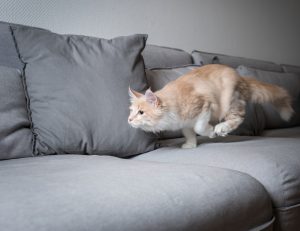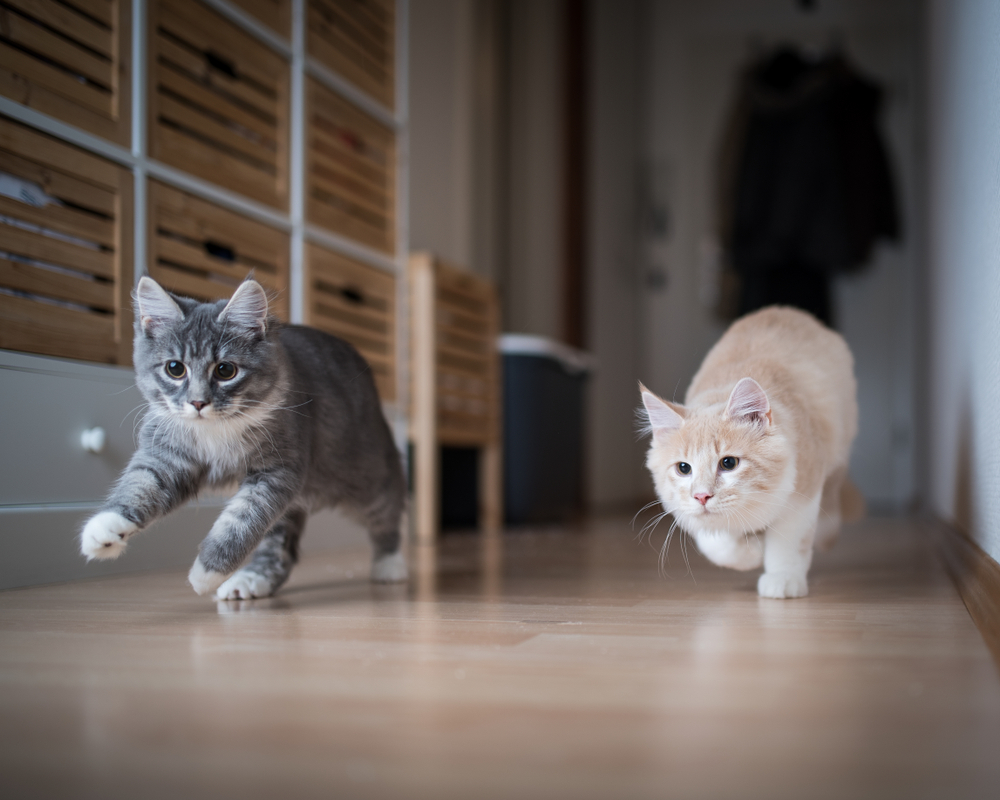Puppies and young dogs are famous for experiencing zoomies. But as any Cat Owner knows, our feline friends are very much prone to them, too. You may have noticed this hyperactive behaviour around dusk, or even later at night when you’re retiring to bed. Particularly if you’ve experienced the latter, you might be curious about how to control cat zoomies so you can enjoy a more peaceful start to your slumber.
Here’s everything you need to know about cat zoomies and what you can do to help burn off your kitty’s energy in a more productive way.
What are zoomies and why do cats get them?
Cat zoomies are effectively quick bursts of energy. They usually see your cat engaging in an array of wild and unpredictable behaviours: doing laps around the living room, running up and down stairs, chasing other animals in the house, and even licking themselves obsessively. Often, a cat will be seemingly calm one moment, then whipping around the house the next.
There are several reasons why cats get the zoomies. These include releasing pent-up energy, indulging their chasing and hunting instincts, or chasing another cat who’s already got the zoomies. Sometimes, though, cats get frisky for no apparent reason.
Kittens are typically more energetic than older cats, so zoomies tend to be more frequent in younger felines. But that’s not to say older cats can’t get them, too! And, because cats are most active at dusk and throughout the evening, you may notice your cat being particularly animated around this time.
Do you necessarily need to control cat zoomies?
Know that zoomies are a completely normal behaviour, and usually not something to worry about. And most of the time, your cat will only experience the zoomies for a few minutes.
In the majority of cases, you don’t really need to worry about controlling cat zoomies. However, there are a few instances where you might want to prevent them from happening.
Firstly, it can be a little frustrating when you’re trying to catch some Zs and your kitty is treating your bed as their personal jumping castle. Secondly, your cat might be getting riskier and riskier with their behaviour, and leaping from things that are unsafe. In either case, you may be looking for ways to curb your cat’s hyperactive behaviour and make playtime more structured.

Four tips to control cat zoomies
Keen to control cat zoomies? Here are a few things you can do.
- Slot in some playtime
Sure, cats can sleep for up to 20 hours per day, but that doesn’t mean they’re entirely idle creatures. They have play needs just like dogs, and meeting these can burn off energy that might otherwise materialise as zoomies.
If you can, try to establish regular playtime with your cat each day. You could do a 15-minute session before or after work. Or, if you’re at home with your furbaby, you can spread this out over the course of the day.
Mix up the toys you play with, too. See if you can include a few games that satisfy your kitty’s need to chase and hunt. Not only is this a lot of fun for them, but it stimulates their brain and senses. Alternatively, try your hand at some DIY cat toys!
- Ensure they’ve got a good resting spot
To encourage your kitty to keep calm, make sure they’ve got spots around the house to rest and hide out. Cats love sitting and sleeping in secluded places, as it helps them feel safe and secure. And a relaxed, less-stressed cat is one that’s less likely to flip out.
Cat tunnels, igloos, and cosy beds are great for this. But you may also find that your cat simply likes hanging out inside a cardboard box. If you’re taking your kitty to your local Cat Sitter for a few days, make sure their favourite sleeping spot goes with them.
- Let them outdoors (if you can)
Your cat is more likely to experience the zoomies if they’ve got a lot of pent-up energy. This is especially the case if they’re an indoor cat or have been kept inside all day.
While it’s not always practical to let your cat roam freely in the outdoors – and, in fact, many areas across Australia require cats to be contained – there are still several ways you can give them the excitement and stimulation of the outside world.
If you have a contained garden, courtyard, or balcony, you could let your cat out for a few hours. If you don’t, an outdoor cat enclosure is a great way to give them a taste of the outdoors without the worry of them running off. And if your cat is comfortable on a leash, you could even try taking them for a walk.
- Consider a second kitty
Despite their reputation as lone creatures, many cats actually love having company. If you’re in a one-cat household, sometimes welcoming a second kitty into your home can be really beneficial.
A second cat provides social stimulation and also gives your existing kitty a playmate. That means that when the zoomies strike, your cat has a buddy to play with. They may also be less likely to try and coax you into playtime in the middle of the night!
Are cat zoomies ever cause for concern?
In some cases, excessive hyperactivity may be a sign of something more serious. In older cats, for example, overactive behaviour can be a symptom of hyperthyroidism.
If your cat really can’t calm down, or the behaviour is accompanied by other symptoms like distress, changing bathroom habits, abnormal cries, or even weight loss, you might want to take your cat to the vet for a check-up.

